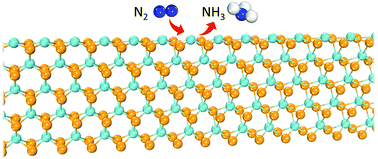Improved nitrogen reduction activity of NbSe2 tuned by edge chirality†
Abstract
Efficient catalysts for the electroreduction of N2 to NH3 are of paramount importance for sustainable ammonia production. Recently, it was reported that NbSe2 nanosheets exhibit an excellent catalytic activity for nitrogen reduction under ambient conditions. However, existing theoretical calculations suggested an overpotential over 3.0 V, which is too high to interpret the experimental observations. To reveal the underlying mechanism of the high catalytic activity, in this work, we assessed NbSe2 edges with different chirality and Se vacancies by using first principles calculations. Our results show that N2 can be efficiently reduced to NH3 on a pristine zigzag edge via the enzymatic pathway with an overpotential of 0.45 V. Electronic structure analysis demonstrates that the N2 molecule is activated by the back-donation mechanism. The efficient tuning of the local chemical environments by edge chirality provides a promising approach for catalyst design.



 Please wait while we load your content...
Please wait while we load your content...